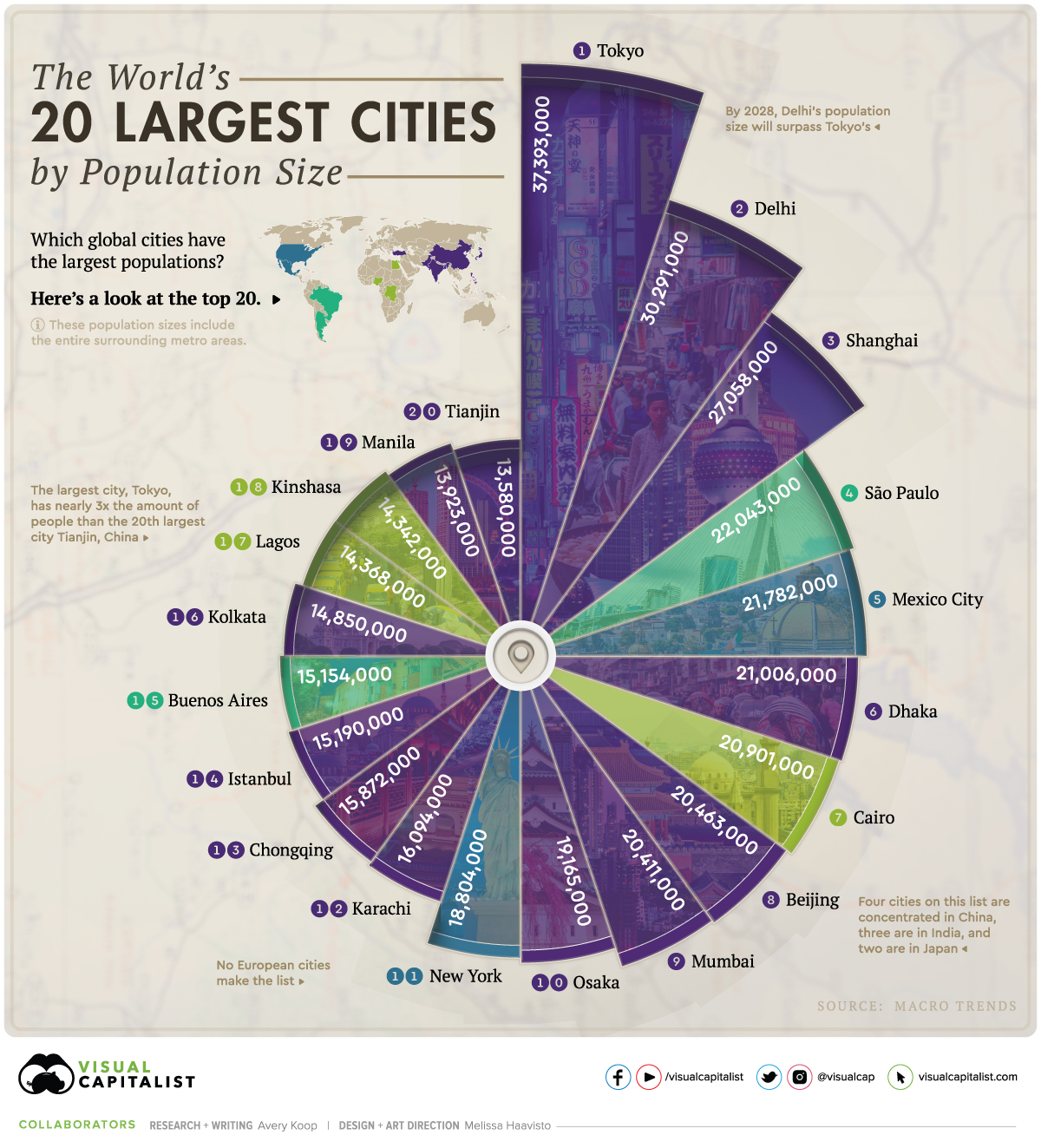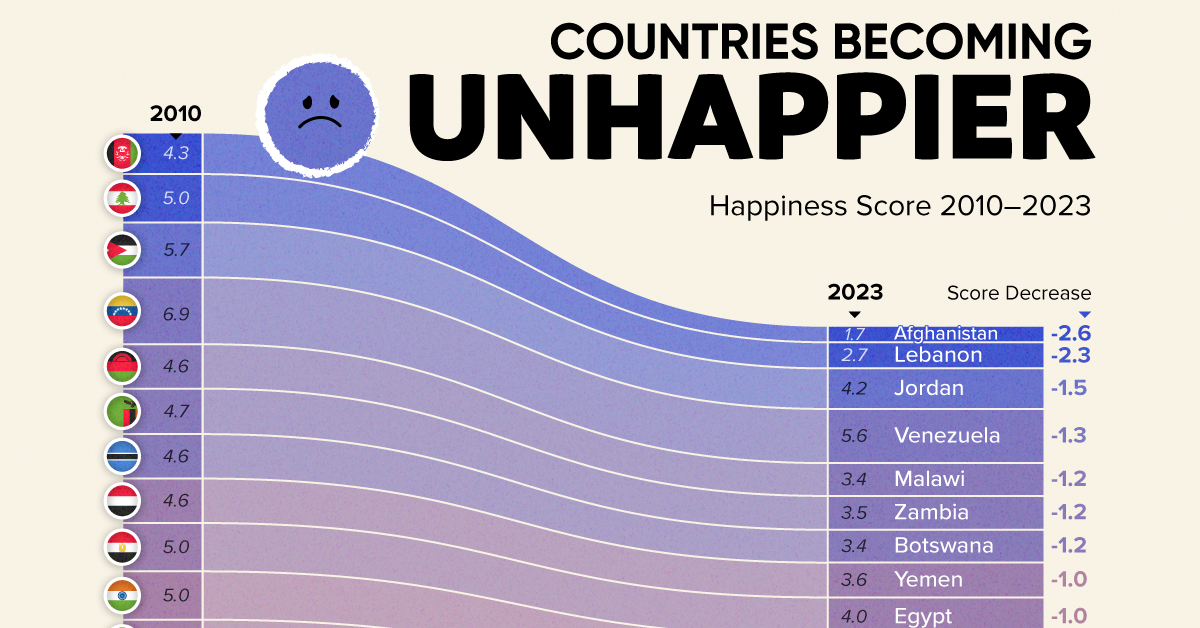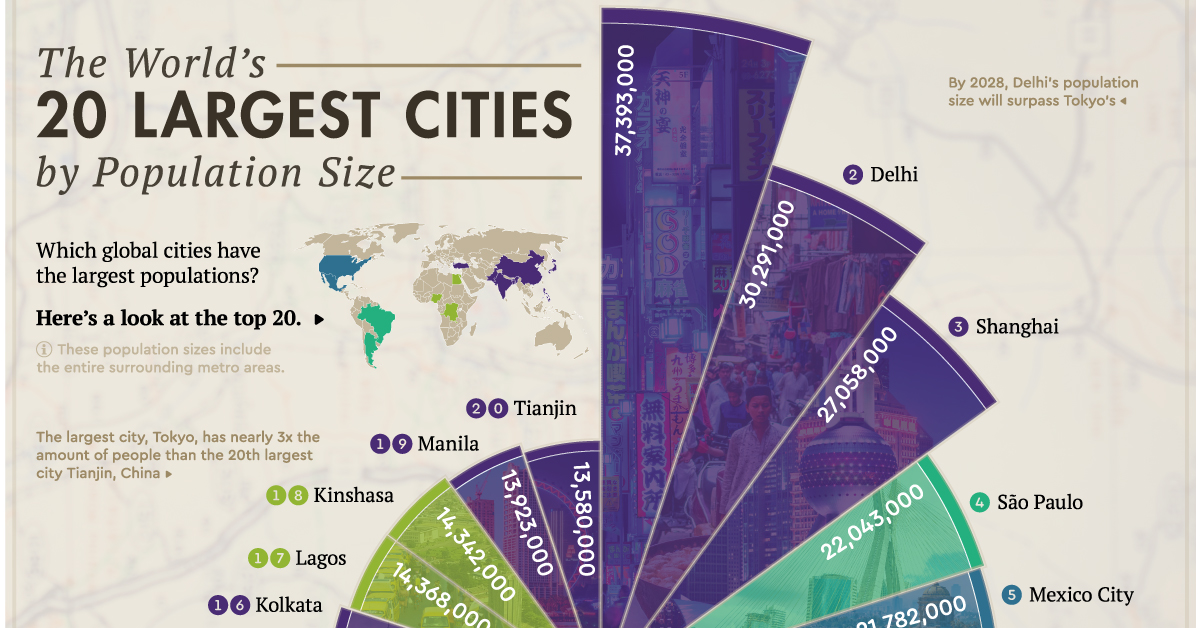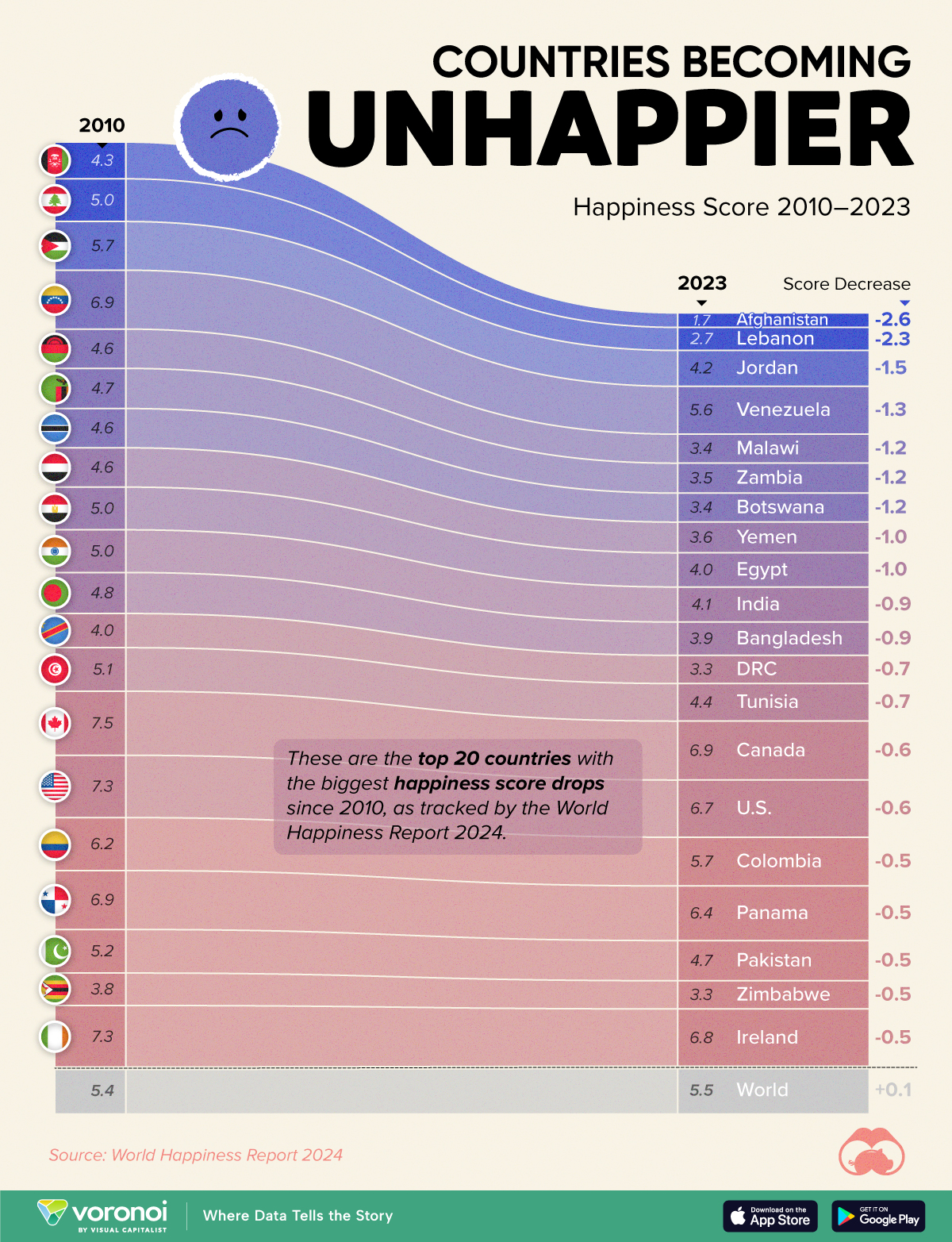Demographics
Ranked: The Most Populous Cities in the World

Ranked: The Most Populous Cities in the World
More than half of the world’s population currently lives in cities—and as time goes on, it’s clear that more urban dwellers will find themselves living in megacities.
Megacities are defined as urban areas with a population of more than 10 million people. This means that the world’s top 20 most populous cities are all megacities.
This visualization, using data from Macrotrends, shows the 20 most populous cities in the world.
Rapid Urbanization
Today, more than 80% of people in higher income countries find themselves living in urban areas, and in upper-middle income countries the number lies between 50-80%.
Rural-to-urban migration is an increasingly relevant trend in the 21st century. Prospects of better job opportunities and higher wages, along with shifts from agrarian to industrial and service-based economies, are causing mass movement to cities.
How much have the world’s five most populous cities grown in just the last decade?
| Rank | City | 2010 Population | 2020 Population | Percentage Change |
|---|---|---|---|---|
| #1 | 🇯🇵 Tokyo | 36,834,000 | 37,393,000 | +1.5% |
| #2 | 🇮🇳 Delhi | 21,935,000 | 30,291,000 | +38.1% |
| #3 | 🇨🇳 Shanghai | 19,980,000 | 27,058,000 | +35.4% |
| #4 | 🇧🇷 São Paulo | 19,660,000 | 22,043,000 | +12.1% |
| #5 | 🇲🇽 Mexico City | 20,132,000 | 21,782,000 | +8.2% |
While Tokyo only gained 559,000 people between 2010 and 2020, Delhi gained over 8 million people in the same time frame.
Shanghai grew by over 7 million people. Meanwhile, São Paulo grew by more than 2 million, and Mexico City gained just over 1.6 million people.
Interestingly, Mexico City placed third on the top largest cities list in 2010, but has since experienced slower growth compared to its competitors, Shanghai and São Paulo.
The Most Populous Cities Today
While Tokyo is the world’s most populous city with 37,393,000 people, this number is leveling out due to declining birth rates and an aging population.
Indian and Chinese cities, on the other hand, will continue to grow rapidly in the coming years. In fact, it’s expected that Delhi’s population could surpass Tokyo’s by 2028.
Here’s a closer look at the top 20 most populous cities.
| Rank | City | Population |
|---|---|---|
| 1 | 🇯🇵 Tokyo | 37,393,000 |
| 2 | 🇮🇳 Delhi | 30,291,000 |
| 3 | 🇨🇳 Shanghai | 27,058,000 |
| 4 | 🇧🇷 São Paulo | 22,043,000 |
| 5 | 🇲🇽 Mexico City | 21,782,000 |
| 6 | 🇧🇩 Dhaka | 21,006,000 |
| 7 | 🇪🇬 Cairo | 20,901,000 |
| 8 | 🇨🇳 Beijing | 20,463,000 |
| 9 | 🇮🇳 Mumbai | 20,411,000 |
| 10 | 🇯🇵 Osaka | 19,165,000 |
| 11 | 🇺🇸 New York City | 18,804,000 |
| 12 | 🇵🇰 Karachi | 16,094,000 |
| 13 | 🇨🇳 Chongqing | 15,872,000 |
| 14 | 🇹🇷 Istanbul | 15,190,000 |
| 15 | 🇦🇷 Buenos Aires | 15,154,000 |
| 16 | 🇮🇳 Kolkata | 14,850,000 |
| 17 | 🇳🇬 Lagos | 14,368,000 |
| 18 | 🇨🇩 Kinshasa | 14,342,000 |
| 19 | 🇵🇭 Manila | 13,923,000 |
| 20 | 🇨🇳 Tianjin | 13,580,000 |
By 2035, two new cities are expected to crack the top 20 list. Specifically, it’s projected that Bangalore (India) and Lahore (Pakistan) will boot out Tianjin and Buenos Aires. In addition, Guangzhou, Shenzhen, and Chennai are all expected to meet the megacity definition by 2035.
Urban growth will continue mainly in Asia and Africa, as some cities in regions such as Europe actually begin to shrink in population due to aging citizens and declining birth rates. Since 2012, deaths in the EU have actually been outpacing births—and in 2019, there were 4.7 million deaths compared to 4.2 million births, though net migration kept population numbers from falling.
Life in the City
While there are certainly downsides to mass urbanization, like pollution and overcrowding, the upsides clearly outweigh the negatives for most people. Convenience, better jobs, easier access to social services, and higher wages are among the many reasons people are likely to continue to move to cities, even in the post-COVID era.
With the emergence of smart and green cities, the quality of life for many urban dwellers will likely continue to improve, and more large urban areas will morph into megacities.
Demographics
The Countries That Have Become Sadder Since 2010
Tracking Gallup survey data for more than a decade reveals some countries are witnessing big happiness declines, reflecting their shifting socio-economic conditions.

The Countries That Have Become Sadder Since 2010
This was originally posted on our Voronoi app. Download the app for free on iOS or Android and discover incredible data-driven charts from a variety of trusted sources.
Can happiness be quantified?
Some approaches that try to answer this question make a distinction between two differing components of happiness: a daily experience part, and a more general life evaluation (which includes how people think about their life as a whole).
The World Happiness Report—first launched in 2012—has been making a serious go at quantifying happiness, by examining Gallup poll data that asks respondents in nearly every country to evaluate their life on a 0–10 scale. From this they extrapolate a single “happiness score” out of 10 to compare how happy (or unhappy) countries are.
More than a decade later, the 2024 World Happiness Report continues the mission. Its latest findings also include how some countries have become sadder in the intervening years.
Which Countries Have Become Unhappier Since 2010?
Afghanistan is the unhappiest country in the world right now, and is also 60% unhappier than over a decade ago, indicating how much life has worsened since 2010.
In 2021, the Taliban officially returned to power in Afghanistan, after nearly two decades of American occupation in the country. The Islamic fundamentalist group has made life harder, especially for women, who are restricted from pursuing higher education, travel, and work.
On a broader scale, the Afghan economy has suffered post-Taliban takeover, with various consequent effects: mass unemployment, a drop in income, malnutrition, and a crumbling healthcare system.
| Rank | Country | Happiness Score Loss (2010–24) | 2024 Happiness Score (out of 10) |
|---|---|---|---|
| 1 | 🇦🇫 Afghanistan | -2.6 | 1.7 |
| 2 | 🇱🇧 Lebanon | -2.3 | 2.7 |
| 3 | 🇯🇴 Jordan | -1.5 | 4.2 |
| 4 | 🇻🇪 Venezuela | -1.3 | 5.6 |
| 5 | 🇲🇼 Malawi | -1.2 | 3.4 |
| 6 | 🇿🇲 Zambia | -1.2 | 3.5 |
| 7 | 🇧🇼 Botswana | -1.2 | 3.4 |
| 8 | 🇾🇪 Yemen | -1.0 | 3.6 |
| 9 | 🇪🇬 Egypt | -1.0 | 4.0 |
| 10 | 🇮🇳 India | -0.9 | 4.1 |
| 11 | 🇧🇩 Bangladesh | -0.9 | 3.9 |
| 12 | 🇨🇩 DRC | -0.7 | 3.3 |
| 13 | 🇹🇳 Tunisia | -0.7 | 4.4 |
| 14 | 🇨🇦 Canada | -0.6 | 6.9 |
| 15 | 🇺🇸 U.S. | -0.6 | 6.7 |
| 16 | 🇨🇴 Colombia | -0.5 | 5.7 |
| 17 | 🇵🇦 Panama | -0.5 | 6.4 |
| 18 | 🇵🇰 Pakistan | -0.5 | 4.7 |
| 19 | 🇿🇼 Zimbabwe | -0.5 | 3.3 |
| 20 | 🇮🇪 Ireland | -0.5 | 6.8 |
| N/A | 🌍 World | +0.1 | 5.5 |
Nine countries in total saw their happiness score drop by a full point or more, on the 0–10 scale.
Noticeably, many of them have seen years of social and economic upheaval. Lebanon, for example, has been grappling with decades of corruption, and a severe liquidity crisis since 2019 that has resulted in a banking system collapse, sending poverty levels skyrocketing.
In Jordan, unprecedented population growth—from refugees leaving Iraq and Syria—has aggravated unemployment rates. A somewhat abrupt change in the line of succession has also raised concerns about political stability in the country.
-

 Science1 week ago
Science1 week agoVisualizing the Average Lifespans of Mammals
-

 Markets2 weeks ago
Markets2 weeks agoThe Top 10 States by Real GDP Growth in 2023
-

 Demographics2 weeks ago
Demographics2 weeks agoThe Smallest Gender Wage Gaps in OECD Countries
-

 United States2 weeks ago
United States2 weeks agoWhere U.S. Inflation Hit the Hardest in March 2024
-

 Green2 weeks ago
Green2 weeks agoTop Countries By Forest Growth Since 2001
-

 United States2 weeks ago
United States2 weeks agoRanked: The Largest U.S. Corporations by Number of Employees
-

 Maps2 weeks ago
Maps2 weeks agoThe Largest Earthquakes in the New York Area (1970-2024)
-

 Green2 weeks ago
Green2 weeks agoRanked: The Countries With the Most Air Pollution in 2023
















